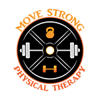Why Your Hip Mobility Isn’t Improving Part III
Hip mobility is key for hip, knee and low back health. It is also key for athletic performance as well as performance in the gym. Limited hip mobility can be a contributing factor for low back and knee pain as well as limitations in your performance for certain lifts such as squats and deadlifts.
Far too often, we hear, “I stretch and stretch, but I still feel tight” or “I have been doing my hip mobility drills, but it isn’t improving.
Make sure to check out Part I HERE and Part II HERE as to why you may not be seeing an improving in your hip mobility.
Often times, we stretch, foam roll, do mobility drills, etc. and we feel “more mobile”, but then things tighten up hours or days later.
Another reason why your hip mobility may not improving is because you are not giving your body a reason to maintain it.
One thing I tell all of my athletes and clients is that we need to train that “new” mobility in order for our body to be able to maintain it.
Let’s go through various drills and which range of motion they are training the body to control.
Hip Flexion
Supine Core Activated Active Straight Leg Raise
Key Points:
-Press down firmly into the ground with your hands.
-Slow and controlled, raise one leg up into the air while making sure to maintain the other leg on the ground.
-Alternate and perform for 5 reps per side.
Supine Psoas March
Key Points:
-Make sure the knee of the leg that is not going down towards the table stays above hip height.
-Alternate side to side for 3 sets x 5 reps per side.
Hip Extension
Cook Hip Lift
Key Points:
-Make sure hip is flexed enough to not allow the ball to fall out.
-If ball falls out, you are not keeping your hip flexed enough.
-Perform slow and controlled 5 reps per side x 3 sets.
Quadruped Assisted Hip Extension
Key Points:
-Keep low back still and don’t let it move.
-Think of pushing the wall back with your leg vs lifting leg up.
-Perform for 5 reps per side alternating for 3 sets.
Tall Kneeling Core Activated Hip Hinge
Key Points:
-Think of “bowing” and move your hips back vs just bending your knees.
-Make sure to finish the movement by bringing your hips forward.
-Finish with your shoulders, hips and knees stacked on top of each other.
-Perform for 3 sets x 5 reps.
½ Kneeling Chops
Key Points:
-Place your lower body in a narrow stance.
-The stance should be challenging, but not so hard where you are shaking and wobbling.
-Bring arms down and across your body and follow with your eyes and head.
-Perform for 2 sets x 10 reps per side.
-Inside leg should be the leg that is up.
Tall Kneeling Chops
Key Points:
-Make sure shoulders, hips, and knees are stacked over each other.
-Bring arms down and across your body and follow with your head and eyes.
-Control trunk position on the way down and up.
-Perform for 2 sets x 10 reps facing each way.
Hip Internal and External Rotation
Supine Assisted Hip ER/IR
Key Points:
-Perform slow and controlled
-3 sets x 5 reps.
Quadruped Assisted Hip ER/IR
Key Points:
-Perform slow and controlled
-3 sets x 5 reps.
Tall Kneeling Hip ER/IR Walkouts
Key Points:
-Perform slow and controlled
-3 sets x 5 reps.
½ Kneeling Chops
Key Points:
-Place your lower body in a narrow stance.
-The stance should be challenging, but not so hard where you are shaking and wobbling.
-Bring arms down and across your body and follow with your eyes and head.
-Perform for 2 sets x 10 reps per side.
-Inside leg should be the leg that is up.
Hip Abduction
Prone Hip ER Lifts
Key Points:
-Place foot on back of opposite knee.
-Keeping pelvis still, lift bent knee slightly off ground.
-Perform for 3 sets x 5 reps.
Now that we have covered various corrective strategies, we need to make sure we load the body in order to help maintain these improvements.
A well structured strength and conditioning program is one of the best correctives out there.
Performing movements such as:
Front Squats
Goblet Squats
Lateral Lunges
Reverse Lunges
Trap Bar Deadlifts



